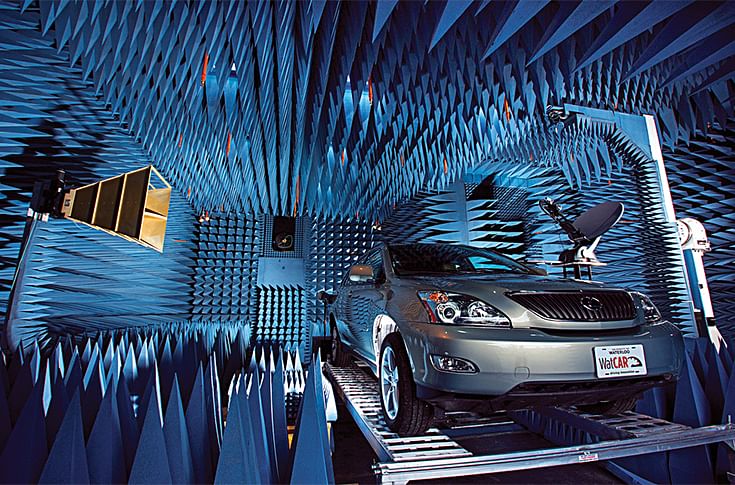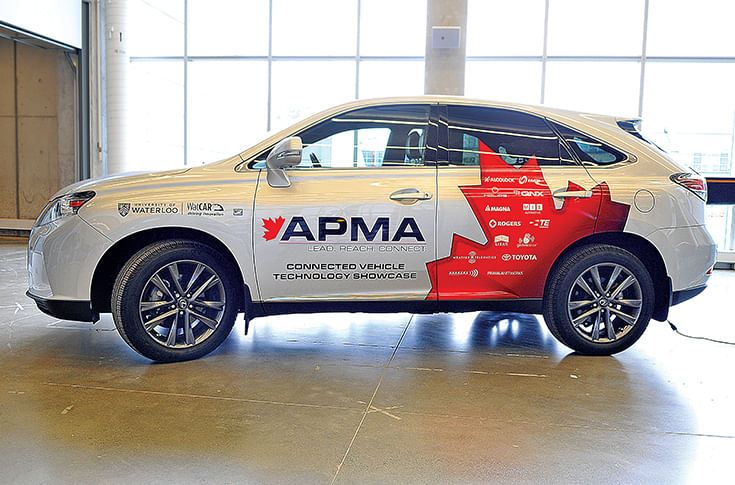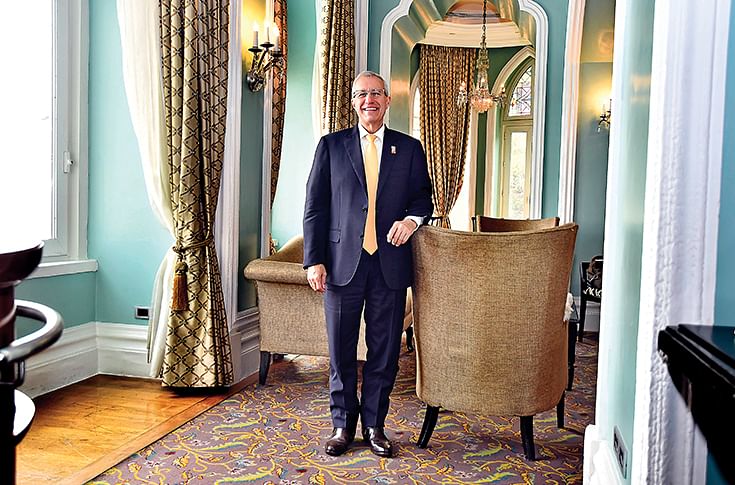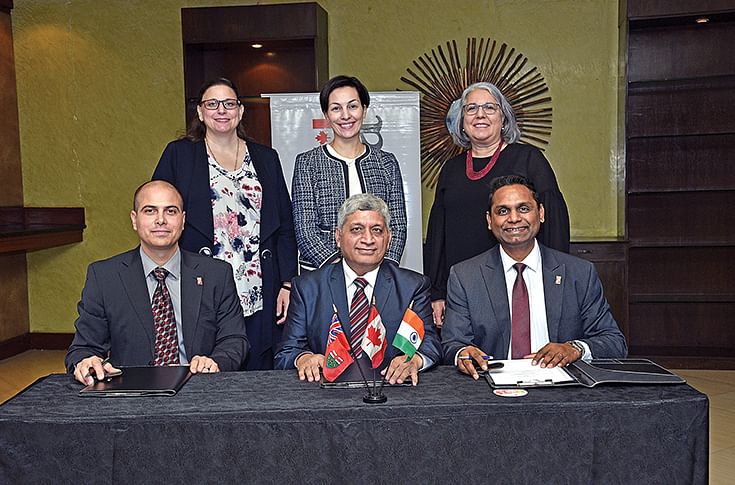Victor Fedeli: ‘The potential for trade between India and Ontario is worth over 35 billion Canadian dollars.’
Victor Fedeli, Ontario’s Minister for Economic Development, Job Creation and Trade, suggests that the province could become the gateway for Indian Auto Inc
Home to the top five global OEMs, over 700 suppliers and 500 tool and mould makers, Ontario might just be the prescription that India Auto Inc needs. Victor Fedeli, Ontario’s Minister for Economic Development, Job Creation and Trade, suggests that the province could become the gateway for Indian Auto Inc to take advantage of NAFTA.
How does your experience as a successful entrepreneur help you in your current role as the Minister of Economic Development, Job Creation And Trade?
We have made Ontario open for business, jobs and trade. That is done by looking at all the areas in Ontario that were obstructing businesses from growth. We have been doing this since the past 16 months since our government is in office.
We are reducing the cost of doing business by 5 billion Canadian dollars (Rs 26,990 crore). Through reduction of taxes, accelerated cost allowance, businesses can write off their new equipment in a year, reduce their insurance premium. All of the things that a government can control, we have reduced those costs. As a result, business communities have hired 256,000 employees in the past 16 months. To put that in perspective, Ontario’s total population is 14 million.
The other area that we have focused on is reducing red tape that has been obstructing growth. By next year, the policy will help reduce cost to business by almost 400 million Canadian dollars (Rs 2,160 crore).
The global auto industry has seen a consistent slowdown. Ontario recently announced a stimulus worth 10 million Canadian dollars. How does this kind of stimulus help the industry?
Automotive is an important segment and we are the No 2 jurisdiction in all of North America, just behind Michigan. Ontario is the only province in Canada, which manufactures automobiles. We manufacture just under two million vehicles, while Michigan produces just over two million vehicles, which gives an idea of the scale. We have a new programme called 'Driving Prosperity' to feature the automotive sector. When put together, there are more than 1,000 tool and die makers and parts manufacturers in Ontario. This package offers support to those organisations and we have had huge success.

The Centre for Intelligent Antenna and Radio Systems (CIARS) is an established research facility in Canada and works on innovation in all aspects of electromagnetic communication and sensing science and engineering.
This year Toyota Motor announced a 1.4 billion Canadian dollar (Rs 7,557 crore) investment in its facility in Ontario. The carmaker also announced that the new line of the Lexus NX will be manufactured in Ontario, and for the third year in a row they won the JD Power Award (Platinum Award), making them the No. 1 auto plant in the world. That tells the rest of the world that we know how to make cars and are leaders in advanced manufacturing in Ontario.
One of the focus areas for your visit is to further grow trade between India and Ontario. How do you view the Make in India initiative?
It works both ways — we see the two-way trade between Ontario and India, quite frankly, to be very small. For me, this offers a great opportunity. The two-way trade between Japan and Ontario is estimated to be around 13 billion Canadian dollars (Rs 70,122 crore); in comparison, the trade between India and Ontario is just 3.2 billion Canadian dollars (Rs 17,260 crore). That tells us that there is a great opportunity to increase the dollar volume. Canadian 2.8 billion dollars (Rs 15,103 crore) is from India to Ontario and only 400 million Canadian dollars (Rs 2,158 crore) is from Ontario to India, so we see a huge opportunity to grow.
Ontario is also the No. 2 IT cluster in all of North America, just behind Silicon Valley. There are more than 22,000 IT companies with more than 300,000 employees, which again is big potential. Why is this important? Because when you marry the two (auto and IT), you have got one province having expertise in both.
We have seen Ford in the connected and autonomous vehicle sector, General Motors opening a facility in the autonomous vehicle sector and also Uber, recently inaugurating a facility in Toronto, the first outside of the USA. This is propelling Ontario to be a centre, which would be of interest to Indian companies. In November 2019, Gurgaon-headquartered VVDN Technologies announced it will open a facility in Ontario with 250-300 engineers.
In November 2017, EESL and EnergyPro had partnered with battery storage solutions provider Leclanche with an initial investment of $12 million (Rs 75 crore) for the utility-scale Canadian Energy Storage Project. What is its current status?
I cannot speak on the specifics of this project, but I can tell you Ontario is a mineral-rich province. We have three different areas which are exciting for battery technologies. We have cobalt, which is of importance in battery manufacturing and it happens to be in the eponymous town of Cobalt in Ontario; lithium material is present in the far-western north area of Ontario and graphene in Northern Ontario. All three states are looking to open up their mines for servicing battery production.
This utility scale project was designed to assist in balancing Ontario’s electricity system grid by providing grid ancillary services such as reactive power, voltage support and frequency regulation. The project completed the first 2 phases in 2018, representing 4 MW or 14 MWh of battery capacity. After completion of the project, the storage capacity will increase to 30 MW or 20 MWh.
On November 28, 2018 in Mumbai, CAMM inked an MoU with TAGMA. Clockwise: Tara Scheurwater, Senior Trade Commissioner in Western India for Ontario; Annie Dube, Consul General, Canada; Dr Terrie Romano, Counsellor (Economic Affairs – Ontario); Rakesh Naidu, COO, Windsor-Essex Economic Development Corporation; D K Sharma, president, Tools and Gauge Manufacturers' Association of India (TAGMA) and Jonathon Azzopardi, president, Canadian Association of Moldmakers (CAMM).
India can benefit from learnings that Ontario is gaining from this project and apply to its own evolving electricity system. Ontario is using several energy storage projects to study how energy storage facilities can be used to increase the efficiency of the system and utilise intermittent resources when they are needed. In addition, Ontario is using energy storage to balance
the electricity system’s supply and demand on a second-by-second basis.
Is that (EV battery) an area of focus to attract investment from India?
I have met with the owners of all mining companies dealing in cobalt, lithium and graphene, and all of them are looking for partners. I am very eager to return home and talk about the opportunities with Indian investors.
Given the geo-political situation in the USA and ongoing trade wars, how do you think Indian companies will benefit from investing in Ontario?
There is an excellent opportunity under the new NAFTA (North American Free Trade Agreement — a treaty between United States, Canada, and Mexico) pact for Indian companies to establish themselves in Ontario as the gateway to North America. There is 35 billion Canadian dollars (Rs 190,365 crore) in trade that companies of Indian origin can establish in Ontario and take advantage of the free trade between Canada, USA and Mexico. Within the automotive sector, we know the localisation is going to change and will increase from 62.5 percent to 75 percent for components. We see this as a great opportunity for Indian companies to enter.
What is the trade value between Ontario and India? Has it grown in the past two years? What share does the automotive industry account for in the bilateral trade?
In 2018, two-way trade between Ontario and India was valued at over 3.2 billion Canadian dollars (Rs 17,299 crore), making it Ontario’s 19th largest export partner in the world.
Two-way trade between Canada and India has grown at a rate of 10 per cent over the last six years, and that number continues to strengthen.
In 2018, automotive exports to India totalled $3.8 million, and imports from India totalled $470.557 million (Rs 2,540 crore), with two-way automotive trade valued at $474.357 million (Rs 2,562 crore).
Can you detail the Indian automakers who are looking to or have already established manufacturing operations in Ontario?
There are currently over 50 Indian companies with investments in Ontario, and we are working hard to increase that number.
For example, in 2017, Indian automotive component maker Hi-Tech Gears acquired Guelph-based Teutech Industries, a component manufacturer with facilities in Ontario and Pennsylvania.
The investment partnership goes both ways. For example, Markham-based parts supplier Novo Plastics has a sales, engineering and development office in Gurgaon, India.
We believe that the growing strategic partnerships between Ontario and India will lead to further opportunities for bilateral trade and investment.
What incentives is the Canadian government offering India Auto Inc to set up manufacturing in the country?
As the only province or state in North America with five OEMs, Ontario has the right environment for automotive investment and expansion.

The Automotive Parts Manufacturers Association's connected vehicle technology demonstrator is an Ontario-built Lexus RX350 fitted with integrated connectivity components from 13 Canadian sources.
By selecting Ontario, companies are choosing a stable and competitive business landscape, and can have confidence in the province’s long-term political and economic outlook. The Ontario government is also committed to working closely with the Canadian Federal government on building infrastructure and promoting economic development.
Ontario has some of the most competitive corporate tax rates, lower than the G7 average. The money companies save by doing business in the province allows them to further invest in innovation and growth — and create jobs along the way.
Ontario also offers an environment full of top tier talent — both from home and abroad. 68 percent of Ontario adults possess a post-secondary education — a rate higher than any OECD country and our universities and colleges provide a stream of high-quality graduates. In fact, The University of Toronto ranks among the top 20 global universities and University of Waterloo graduates are the second most frequently hired by Silicon Valley companies.
Global expansion is an important part of a company’s lifecycle, and India is a great place for our automotive companies to invest.
With the Indian robotics and ICT sectors on the rise, Ontario can take advantage of a growing, thriving ecosystem, while also using its expertise and know-how to support the development of these sectors.
Can you let us know the details of the partnership between CAMM and ACMA inked in 2018?
The Ontario government is thrilled about the partnership between CAMM and ACMA. This is great news for both of our automotive sectors. CAMM will be part of a larger Ontario automotive delegation that will be showcasing Canadian capabilities at the India Auto Expo 2020 in New Delhi.
Ontario companies and industry associations are excited by the prospect of partnership opportunities with their peers in the Indian automotive sector.
During the interaction you mentioned that there is $35 billion Canadian (Rs 190,365 crore) in trade that companies of Indian origins can establish in Ontario and take advantage of the free trade between Canada, USA and Mexico?
Canada, and by extension, Ontario is known as a trading market. Canada currently has free-trade agreements with over 40 countries and is the only member of the G7 to have free trade agreements with all other G7 nations.
The North American Free Trade Agreement between Canada, the United States and Mexico has been in place for 25 years and represents the largest free-trade region in the world by GDP. Companies that choose to expand and invest in Ontario have access to this invaluable partnership.
The province is also known for its ease of access to the global marketplace. With over a dozen border crossings into the United States, all connected by more than 250,000 kilometres of roads and highways, it’s easy to do business with Ontario’s neighbour to the south.
Canada’s largest airport also resides in Ontario, with more than 1,000 daily flights to destinations across the world, and connections to many of the over 300 regional airports in communities right across the province.
(This interview was first published in the December 15, 2019 Anniversary issue of Autocar Professional)
RELATED ARTICLES
India: A Bastion Of Stability for Schaeffler
German autoparts maker Schaeffler’s CEO, Klaus Rosenfeld, describes India’s role in the company’s €24-25 billion empire....
'No Question of Us Being Late' - Suzuki India on e-2Wheeler Market
Suzuki Motorcycle India believes its EV entry is timely as the market is now mature enough to grow off genuine demand ra...
'India Can Become a Major Pillar for Us' - Marquardt Group
Björn Twiehaus, CEO of Marquardt Group, and Vishal Narvekar, the company's India GM, share their outlook on the Indian m...





 19 Jan 2020
19 Jan 2020
 12220 Views
12220 Views







 Ketan Thakkar
Ketan Thakkar


 Angitha Suresh
Angitha Suresh

 Darshan Nakhwa
Darshan Nakhwa

